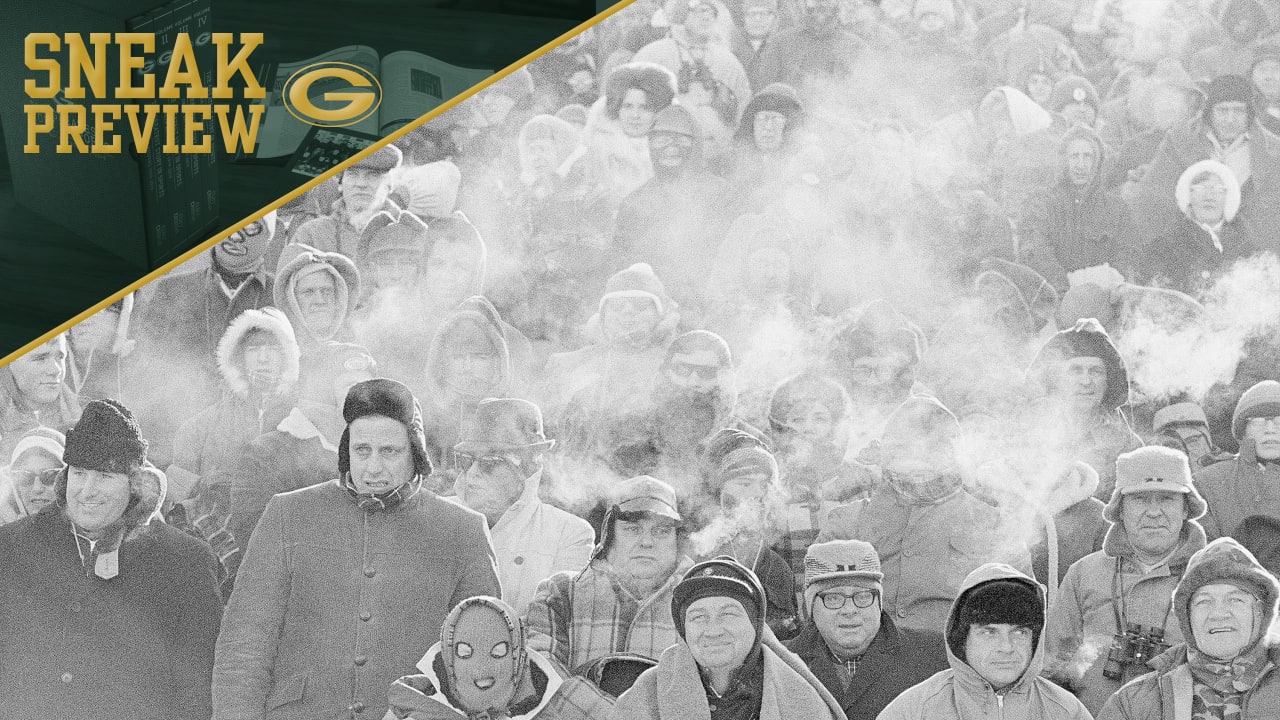
A Picture Worth 1,000 Words – Is there another photo that has been taken of any other sport, any other league, any other team that serves as a better testament to the loyalty and passion of one's fans than this one of Packers fans?
A Bite of Text – Three days after the Packers clinched the West and assured Green Bay of hosting an NFL Championship Game for the first time in its history, more than 100 local businessmen and women gathered for breakfast at the Beaumont Hotel and presumptuously adopted a new nickname for the city: Titletown, U.S.A.
Robbing the Databank – It's hard to imagine any team in NFL history coming closer to perfection than the Packers when they beat Philadelphia, 49-0, in 1962. They outgained the Eagles, 628 yards to 54. Their edge in first downs was 37 to three. Their seven scoring drives covered 86, 89, 85, 76, 71, 66 and 65 yards.
A Secret to Share – President John F. Kennedy didn't need to intercede to get Paul Hornung a pass to play in the 1961 NFL championship. Hornung already was granted a leave that would have started on Dec. 27. However, that would have limited him to three days of practice. Vince Lombardi wanted Hornung to practice all week. And what did "The Golden Boy" do upon his arrival in Green Bay with Kennedy's apparent help? Found a date for the city's annual Charity Ball.
Memory to Cherish – Bart Starr's game-winning quarterback sneak with 13 seconds remaining in the Ice Bowl. It's the most famous play in Packers history; it might be the most famous play in NFL history.
Deathbed Moment – In the summer of 1961, when Federal Judge Allan K. Grim of Philadelphia voided the single-network television deal negotiated by NFL commissioner Pete Rozelle. Fortunately, months later, Congress passed and Kennedy signed a television sports bill that essentially allowed for revenue sharing, assuring the Packers of the same take as the other teams in the league from TV's pot of gold. Had the bill not passed, the Packers might not be in existence today. After all, there was a point in the process where club owners and TV executives discussed how it might be less expensive to telecast a home game of the Chicago Bears into the Wisconsin area than to air Packers road games.
If You Were a Fan – At least 10 times during the 1960s, and maybe even more often, crowds of thousands greeted the victorious Packers upon their return home to Green Bay's Austin Straubel Field after big victories. The largest crowd, estimated at 15,000, was at the airport when the Packers returned from Dallas at midnight following their victory in the 1966 NFL championship.
Shattering Myths – Lombardi's power sweep was his signature play. His version of it was created solely by him, according to Phil Bengtson, who coached in the NFL for nearly 25 years starting in 1951, and it was unique first to the New York Giants – where Lombardi was an assistant – and then to the Packers, according to Red Cochran, who spent nearly 50 years in the NFL as a player, coach and scout starting in 1947. Maybe as much 90 percent of the time, according to coaches and players from the Lombardi era, the play was run to the right. The call in the huddle was "Red Right 49." In the words of Lombardi "the halfback is the ball carrier." That was true even if the power sweep was run to the left. That's not to say fullback Jim Taylor never ran the power sweep. There were plays in sight of the goal line and plays from a rarely used "Green" formation where the halfback and fullback flipflopped and Taylor ran the power sweep. But for the most part in Lombardi's offense, the fullback ran primarily to the weak side, including a weak-side sweep, where either Max McGee or Boyd Dowler moved closer to the tackle and had to exercise the tight end's block. For that reason alone, the weak-side sweep wasn't a staple of Lombardi's offense. Yet the Pro Football Hall of Fame and NFL Films in segments on the power sweep leave the impression that Taylor ran the play as much as Hornung, if not more, and incorrectly refer to plays as the power sweep that weren't.
Best Player – Paul Hornung. "He is the greatest player I've ever coached," Lombardi said in a speech in 1967 before his final season as coach of the Packers. In 1959, Hornung also was the player that Lombardi built his offense around. "In my offensive patterns, the left halfback is the key operative," said Lombardi. Who would know better?
Overlooked by History – The 1960s Packers are the only team in the history of the NFL to win five championships in a decade and the only team in the 87-year history of the NFL playoffs to win three straight championships. Interestingly, the only player from those Packers teams among the 100 chosen for the NFL's All-Centennial team was Forrest Gregg.
Among the Chapter's Rare Photos – A full-page color photo of Lombardi from the Art Shay Archives. Shay was a renowned photographer for Life, Time and Sports Illustrated magazines.
Biggest Game – Is there any other choice than the Ice Bowl? Actually, there was: the 1961 NFL Championship Game. The Packers had won six titles by then, but had never hosted a championship in Green Bay. The genuine anticipation showed by fans in the weeks prior to the game might have been unmatched in Packers history. But, then again, the Ice Bowl symbolizes the Packers like no other game.
"loyalty" - Google News
October 14, 2021 at 09:32PM
https://ift.tt/3DFqI8j
Sneak preview: No better depiction of loyalty and passion - Packers.com
"loyalty" - Google News
https://ift.tt/2VYbPLn
https://ift.tt/3bZVhYX
Bagikan Berita Ini














0 Response to "Sneak preview: No better depiction of loyalty and passion - Packers.com"
Post a Comment